Deployment Overview
This document describes how to set up multi-factor authentication (MFA) for JetBrains Hub with AuthPoint as an identity provider. JetBrains Hub must already be configured and deployed before you set up MFA with AuthPoint.—
This integration was tested with JetBrains Hub v2020.1.
JetBrains Hub Authentication Data Flow with AuthPoint
AuthPoint communicates with various cloud-based services and service providers with the SAML protocol. This diagram shows the data flow of an MFA transaction for JetBrains Hub.

Before You Begin
Before you begin these procedures, make sure that:
- End-users can log in to JetBrains Hub
- A token is assigned to a user in AuthPoint
- You have an AuthPoint identity provider (IdP) certificate (go to Certificate Management)
Configure JetBrains Hub
To start, you must download the metadata file from the Certificate Management page in the AuthPoint management UI. Once you have that, you can configure JetBrains Hub.
- Log in to WatchGuard Cloud.
- From the navigation menu, select Configure > AuthPoint. If you have a Service Provider account, you must first pivot to your Subscriber view.
- Select Resources.
- Click Certificate.

- Next to AuthPoint certificate you will associate with your resource, click
 and select Download metadata. We recommend that you choose the certificate with the latest expiration date. If you do not have a certificate, or if all of your certificates have expired, click Add Certificate and use the newly created certificate.
and select Download metadata. We recommend that you choose the certificate with the latest expiration date. If you do not have a certificate, or if all of your certificates have expired, click Add Certificate and use the newly created certificate.The AuthPoint metadata provides JetBrains Hub with information necessary to identify AuthPoint as a trusted identity provider.
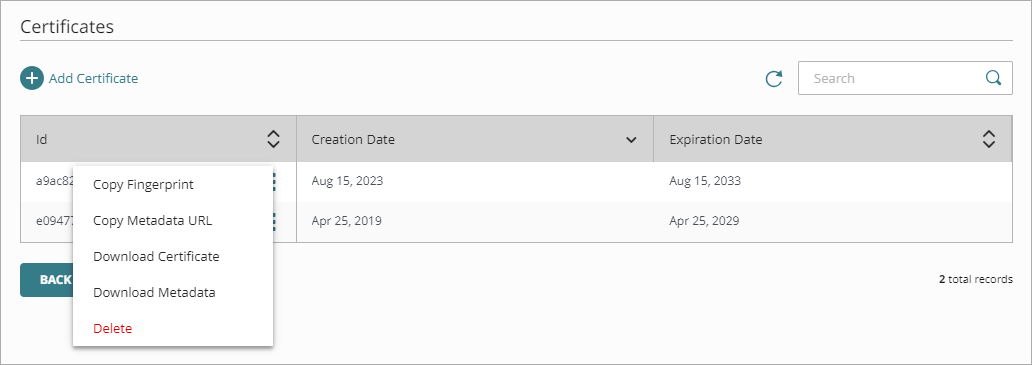
- Next to the same certificate, click
 and select Copy Fingerprint.
and select Copy Fingerprint.
The Copy Fingerprint window appears. - From the Algorithm drop-down list, select SHA-256.
- Click Copy next to the formatted or unformatted fingerprint. We recommend you leave this window open for reference.
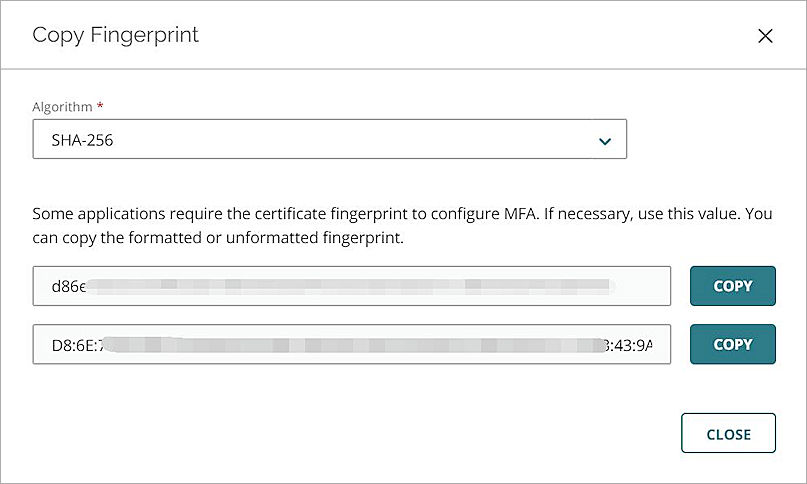
- Log in to your JetBrains Hub with administrative account.
- Click Administration button at the up-right corner, select Auth Modules.
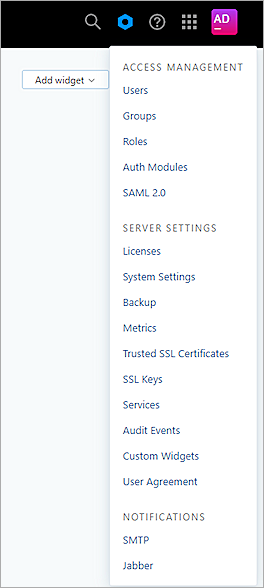
- Select New module > SAML 2.0.
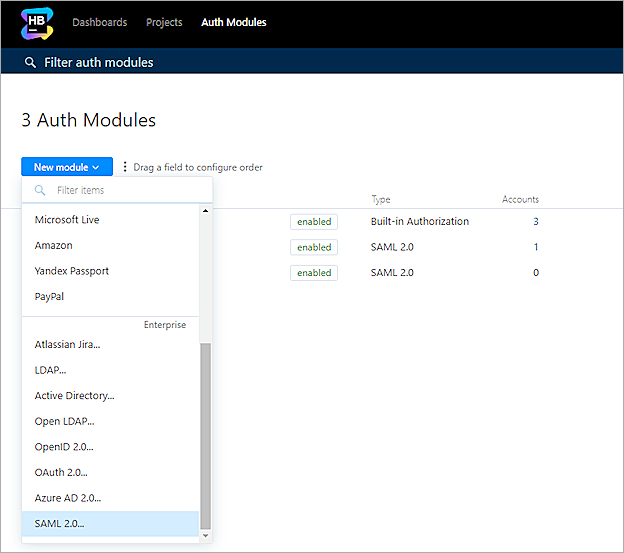
- Type a name for the module. In our example, we name it AuthPoint.
- Open the AuthPoint metadata file you downloaded and find the SingleSignOnService Location and entityID values.
- In the SAML SSO URL text box, paste the SingleSignOnService Location value from the AuthPoint metadata file.
- In the IdP entity ID text box, paste the entityID value from the AuthPoint metadata file.
- In the Certificate fingerprint text box, paste the SHA-256 fingerprint from the Copy Fingerprint window in AuthPoint.
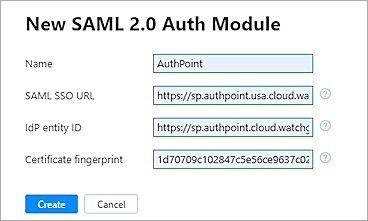
- Click Create.
- On the details page, copy the SP entity ID and ACS URL values. These are used in the next section to configure the SAML resource in AuthPoint. We recommend you leave this window open for reference.
You can choose to enable or disable User Creation. If you disable User Creation, user accounts must match in AuthPoint and JetBrains Hub.
- Click Save.

Configure AuthPoint
Before AuthPoint can receive authentication requests from JetBrains Hub, you must add a SAML resource in AuthPoint. You must also create a Zero Trust authentication policy for the JetBrains Hub resource to determine which users can authenticate and log in to JetBrains Hub and which authentication methods they can use (Push, QR code, and OTP).
Add a SAML Resource in AuthPoint
From the AuthPoint management UI:
- From the navigation menu, select Resources.
Click Add Resource.
The Add Resource page opens.

- From the Type drop-down list, select SAML.
Additional fields appear.

- Type a name for this resource.
- From the Application Type drop-down list, select JetBrains.
- In the Service Provider Entity ID text box, paste the SP entity ID value from JetBrains Hub.
- In the Assertion Consumer Service text box, paste the ACS URL value from JetBrains Hub.
- From the AuthPoint Certificate drop-down list, select the certificate to associate with your resource. This must be the same certificate that you downloaded the metadata for in the previous section.
- Click Save.
Add a Group in AuthPoint
You must have at least one user group in AuthPoint to configure MFA. If you already have a group, you do not have to add another group.
To add a WatchGuard Cloud-hosted group to the WatchGuard Cloud Directory:
- Go to Configure > Directories and Domain Services.
- Click the WatchGuard Cloud Directory domain name. If you have not yet added the WatchGuard Cloud Directory, click Add Authentication Domain and select the WatchGuard Cloud Directory.
The New Group page appears.

- In the Groups tab, click Add Group.
- In the Group Name text box, type a descriptive name for the group.
- (Optional) In the Description text box, type a description of the group.

- Click Save.
Your group is added to the WatchGuard Cloud Directory and to AuthPoint.
Add a Zero Trust Authentication Policy
Zero Trust policies specify which resources users can authenticate to and which authentication methods they can use (Push, QR code, and OTP).
You must have at least one Zero Trust authentication policy that includes the JetBrains Hub resource. If you already have Zero Trust authentication policies, you do not have to create a new authentication policy. You can add this resource to your existing authentication policies.
Users that do not have an authentication policy for a specific resource cannot authenticate to log in to that resource.
To configure a Zero Trust authentication policy:
- Go to Configure > Zero Trust. If you have a Service Provider account, you must select an account from Account Manager.
- Click Add Policy.
- Type a name for this policy.
- In the Target section, from the Content drop-down list, select which groups this policy applies to. You can make multiple selections to add multiple groups.
- In the Resources section, select the AuthPoint resources this policy applies to.
- In the Conditions section, select the conditions that apply to this policy. When you add a condition to an authentication policy, the policy applies only to user authentications that match the policy and the policy conditions. For example, if you add a Network Location to a policy, the policy only applies to user authentications that come from that Network Location. Users who only have a policy that includes a Network Location do not get access to the resource when they authenticate outside of that Network Location (because they do not have a policy that applies, not because authentication is denied). For more information, go to About Zero Trust Conditions.
- (Optional) To create a new condition, click Add New Condition. After you create a new condition, you must still add the condition to the policy.
- From the Type drop-down list, select the type of condition to add to the policy.
- From the Name drop-down list, select which condition of the chosen type to add to the policy.
- To add more conditions, repeat Step 6.
If you add conditions to a policy, we recommend that you create a second policy for the same groups and resources without the conditions. Assign a higher priority to the policy with the policy objects. For more information about priority, go to About Zero Trust Policy Precedence.
- In the Action section, select an option to specify whether to allow or deny authentications for the resources in this policy. In our example, we want to allow authentications.
- Allow — Allow user groups in this policy access to the resources associated with this policy.
- Deny — Deny authentications when users in the groups associated with this policy try to authenticate to the resources associated with this policy.
- If you allow access with this policy, select the check box for each authentication option users can select when they authenticate to resources in this policy with MFA.
For SAML resources, if you select more than one authentication option, users must select one of the available options when they authenticate. For example, if you select OTP and Push, users can choose to type their OTP or approve a push to authenticate. You cannot require that they do both.
- Click Save.
Your policy is created and added to the end of the policy list. - Review the order of your policies and adjust as necessary. For more information about priority, go to About Zero Trust Policy Precedence.
Before you assign users to a group, you must add the users to AuthPoint. You can manually add user accounts or import user accounts from an external user database. For more information on how to add user accounts, see Add User Accounts.
Test the Integration
To test AuthPoint MFA with JetBrains Hub, you can authenticate with a mobile token on your mobile device. For SAML resources, you can choose any method (push, QR code, or one-time password).
In this example, we show the push authentication method (users receive a push notification in the mobile app that they must approve to authenticate).
- In a web browser, go to the JetBrains Hub URL.
- At the bottom of the login page, select the icon for your IdP (AuthPoint).
You are redirected to the AuthPoint authenticaiton page.
![]()
- Type your email address or AuthPoint user name. Click Next.
- If required, in the Password text box, type your password.
- For the authentication method, select Push.
- Click Send.
- Approve the authentication request that is sent to your mobile device.
You are logged in to JetBrains Hub.